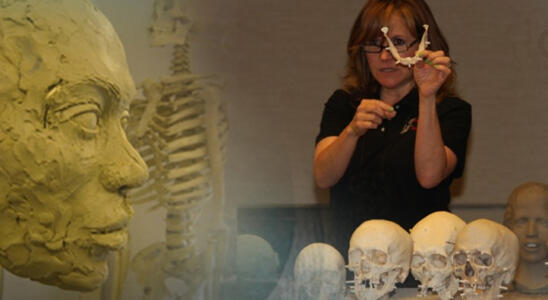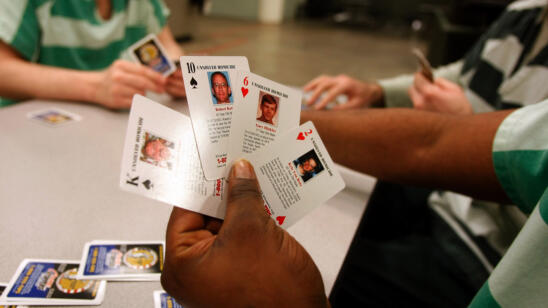The FBI has been solving crimes with DNA evidence for more than two decades, creating the Combined DNA Index System—or CODIS—in 1994, allowing investigators to link unsolved crimes by the raw genetic material left behind at the scene.
The strength of DNA evidence is its specificity: Everyone’s DNA is different (with the exception of identical twins), so if a perpetrator’s DNA can be tied to a crime scene, their presence there is near-irrefutable.
But DNA isn’t just a new kind of fingerprint… it’s also the blueprint of the body. As such, an exciting new field of forensics has emerged: DNA phenotyping, where investigators interpret DNA left behind at the scene to make predictions about what the person might look like.
A&E True Crime spoke with Ellen Greytak, the director of bioinformatics at Parabon NanoLabs—a company that specializes in constructing “Snapshots” (i.e. police sketches) from nothing more than a swab of spit, a drop of blood, a stray hair.
How can you tell what someone looks like by their DNA?
The first thing we have to do is evaluate the DNA sample, make sure it’s good enough quality to succeed. Then, if we accept it, we arrange for that DNA sample to be sent to one of our genotyping labs. They generate close to a million pieces of data on that sample—it takes about four days—and then they transfer the data to us. We get a big text file… and then we run it through our predictive models.
We had thousands of research subjects, volunteers who…donated their DNA. And we used that [DNA] to build predictions. We were looking through all of those subjects to say, ‘What’s consistent about the people with blue eyes that’s different from people who don’t have blue eyes?’
What traits does your model predict for?
Hair color, eye color, skin color, freckling, face shape and ancestry.
We put it all together in a report, and that also comes with a composite. When we predict face shape, we’re predicting a three-dimensional face, [including] pigmentation. Then a forensic artist comes in and puts it together.
How’s business?
We announced commercial availability at the end of 2014. Initially it was pretty slow to get traction because it sounds pretty sci-fi. The first case we solved was in January 2017.
It’s certainly been accelerating. In the last two months there’s been a huge increase in the number of cases we’ve been getting. We’ve worked about 200 cases [so far]. And a lot of those are just in the last couple months.
What are the ideal circumstances under which investigators can use this?
It’s important to remember that it’s not for individual identification. It’s really giving police a way to eliminate a large number of people, who do not resemble that identification.
There was a case from Agawam, Massachusetts: a 25-year-old cold case of a woman who had been murdered. The police were looking to get the case restarted. So they went back through the list of the hundreds of people they’d investigated or considered…and said, ‘Is there a way we can narrow down who we should talk to?’ So they used DNA phenoytyping to prioritize that list; there were only a couple of guys on that list who matched these predictions. They said, that’s a good place to start—we’ll go talk to them, to see if they’d be willing to exclude themselves through DNA samples. When they went to try to talk to one of them, he fled.
Eventually they were able to find him and get DNA; it matched.
[Editor’s note: The accused, Gary Schara, has pleaded not guilty to charges of murder, kidnapping and aggravated rape. He was in pretrial proceedings at Hampden County Superior Court at time of publication.]
Some civil liberties groups have expressed concern about DNA phenotyping, saying it casts too wide a net and thus can turn people undeservingly into suspects. What’s your response to that?
All we’re really doing is delivering to the police the same information that a witness would. If a witness describes a person to the police, and the police used that information to do their investigation…is that the witness’s fault for how they described the person?
We’re very clear when we deliver the information that this is not individualizing, but it’s going to help you narrow the focus of your investigation. It shouldn’t be used to look at [just] anyone who resembles this, but it should be used to focus on people who have other investigative reasons to look at them.
What are the limitations of phenotyping?
The big thing is age. Your DNA sequence does not change with age. There are other changes that happen to cells over time that could be used to determine someone’s age…but it’s not commercially available yet. Right now, all our predictions come out as young adults.
We can’t predict hair style, we can only predict color. How they wear their hair, if they have scars or tattoos: that’s not in the DNA. It’s not a photograph.
Any Snapshots you’ve generated that you’re particularly proud of?
One [from] Lake Brownwood, Texas was a really good one. In that case, investigators released the snapshot…. They got several tips about a particular individual who had not been on their radar. It was someone who had known the victim, but was not strongly connected.
And when he saw the composite, he ended up confessing.
Where do you see the technology going in the next few years?
We’d like to do shape of the hair: curly, wavy, straight..
Same with hair color. Hair can be really difficult, because it can often be blonde in children, but some hair stays blonde and some darkens. What’s the [genetic] signal?
Red hair is very interesting in that it’s a completely different genetic mechanism than hair darkness: some people have bright red hair, some people have a red tint. That’s not really captured [yet]. It’d be nice to know the degree of redness.
With the data we collect, we’ll be able to produce even more accurate predictions. I’m excited by the possibility of predicting age. If there’s a way to do that with a small amount of DNA, that’d be really significant.
Related Features:
Forget Polygraphs: Brain-Scan Lie Detectors Are Coming
How Animal DNA Puts Killers Behind Bars
The Golden State Killer and Other Serial Killers Who Mysteriously Stopped Murdering


